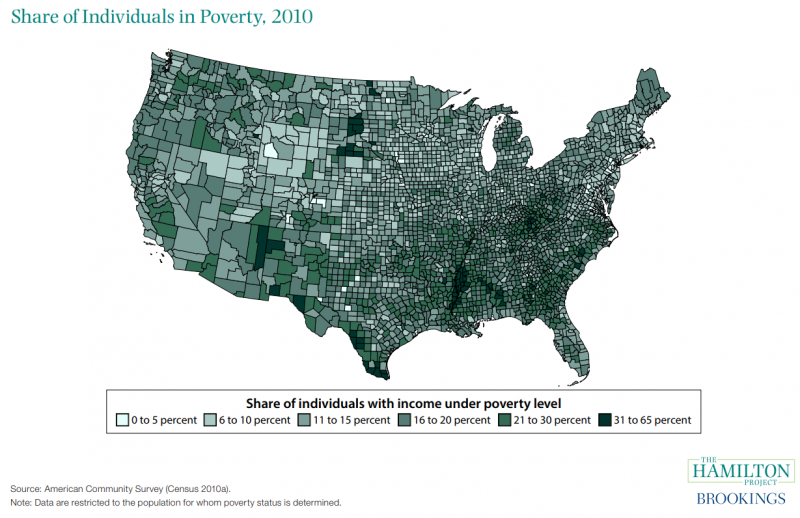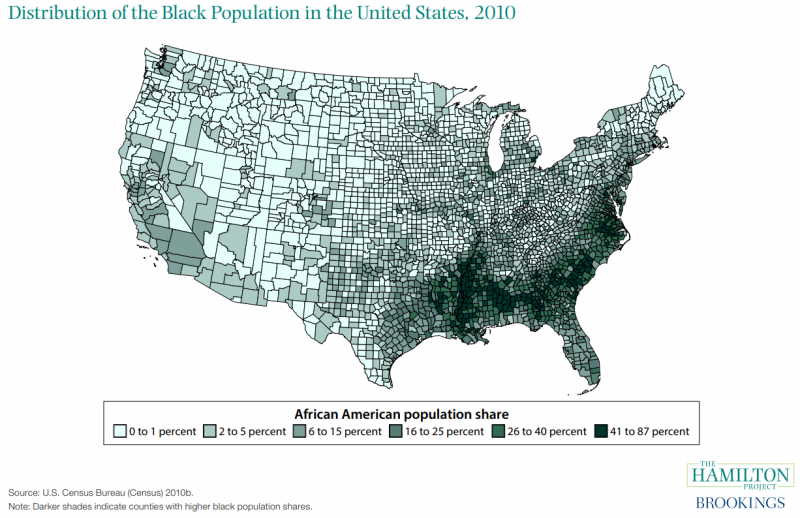It is an article of the American faith that, with education and hard work, all of us have the opportunity to build a better life than was available to our parents. However, many African Americans today remain situated in communities with the lowest prospects for upward mobility. This is not an accident: it reflects both the intended and unintended consequences of U.S. policies that have shaped where people live and the opportunities people have in those communities.
In a recent Hamilton Project paper, The Historical Role of Race and Policy for Regional Inequality, economists Bradley L. Hardy, Trevon D. Logan, and John Parman examine how the spatial distribution of the black population has evolved over time and how this has interacted with economic mobility and U.S. public policy. Their analysis emphasizes the importance of both place and policy in determining individual outcomes.
The Regional Concentration of the African American Population
Despite the Great Migration of millions of African Americans from the rural South to cities across the United States, the modern distribution of black Americans closely relates to the historical patterns of the black population. Counties with disproportionately high shares of black Americans today are the same counties that had large black populations before the Civil War, suggesting that historical conditions have had extremely persistent impacts on the outcomes of African Americans. Moreover, as illustrated in the figure below, poverty in the Deep South tend to be much higher in counties with high black populations.
Relative to the general population, black households today are far more likely to live in the South or in urban areas in the Midwest, and far less likely to live in the West (as seen in figure below). Therefore, any economic shifts that disadvantage the South and Midwest could disproportionally affect African Americans.
Differences within regions—across cities, suburbs and rural areas—also affect racial inequality. The black population tends to be more concentrated in the central counties of large metropolitan areas relative to the white population. By contrast, the white population tends to live in smaller metropolitan areas and in rural counties.
This concentration of the African American population is not accidental. As Hardy, Logan, and Parman detail, influences ranging from discrimination and intimidation, to lender behavior, to white flight from cities, to public policies like redlining or highway construction all combined to keep the African American population more concentrated in particular communities.
Economic Mobility
Recent research by Raj Chetty and coauthors has illuminated the differing potential for intergenerational mobility that exists across the United States. Overlaying this pattern with the spatial distribution of the black population yields some disturbing results: areas with a large black population are likely to be places where black individuals experience particularly low levels of economic mobility. In the South, these low mobility rates for black individuals are substantially lower than corresponding rates for white individuals.
Regions in the North and West, with small black populations, exhibit levels of mobility for black individuals that are both higher and comparable to those of white individuals, but these are regions with relatively small black populations. The regions where the bulk of black Americans live are the ones where their upward mobility is relatively low.
The Connection of Racial and Regional Inequality
The high concentration of the African American population in particular areas has also meant that policies or practices that disadvantage the black community will wind up reinforcing particular patterns of regional or spatial inequality. While many of the most egregious policies designed to promote and encourage racial discrimination have been outlawed, research has shed light on the ways that their effects linger and interact with contemporary policies.
As Hardy, Logan, and Parman explain, there are a range of policies or practices that continue to disadvantage black individuals and communities throughout the U.S., impacting areas including:
-
Public education, which has often been underfunded in African American majority schools, limiting skill acquisition and upward mobility for black Americans.
-
Employment discrimination, which makes it more difficult for black families to escape from poverty or build wealth in their community.
-
The social safety net system, where there is an increased likelihood of sanctioning and spending is less generous for black communities.
-
The criminal justice system, where poor outcomes for black Americans include higher bail and greater likelihood of monetary sanctions, among other penalties.
Given the history and the concentration of the black population throughout the U.S., regional inequality is often shaped by racial inequality, and taking steps to combat regional inequality will need to recognize this source. Accordingly, identifying mechanisms to not only address, but actually reverse, the ongoing effects of discriminatory policies and practices is not only a moral imperative: it is also a pressing economic concern.




